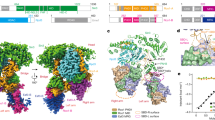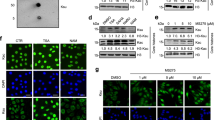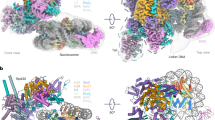Abstract
Reversible histone methylation and demethylation are highly regulated processes that are crucial for chromatin reorganization and regulation of gene transcription in response to extracellular conditions. However, the mechanisms that regulate histone-modifying enzymes are largely unknown. Here, we characterized a protein kinase A (PKA)-dependent histone lysine demethylase complex, PHF2–ARID5B. PHF2, a jmjC demethylase, is enzymatically inactive by itself, but becomes an active H3K9Me2 demethylase through PKA-mediated phosphorylation. We found that phosphorylated PHF2 then associates with ARID5B, a DNA-binding protein, and induce demethylation of methylated ARID5B. This modification leads to targeting of the PHF2–ARID5B complex to its target promoters, where it removes the repressive H3K9Me2 mark. These findings suggest that the PHF2–ARID5B complex is a signal-sensing modulator of histone methylation and gene transcription, in which phosphorylation of PHF2 enables subsequent formation of a competent and specific histone demethylase complex.
This is a preview of subscription content, access via your institution
Access options
Subscribe to this journal
Receive 12 print issues and online access
$209.00 per year
only $17.42 per issue
Buy this article
- Purchase on Springer Link
- Instant access to full article PDF
Prices may be subject to local taxes which are calculated during checkout






Similar content being viewed by others
References
Kouzarides, T. Chromatin modifications and their function. Cell 128, 693–705 (2007).
Ruthenburg, A. J., Li, H., Patel, D. J. & Allis, C. D. Multivalent engagement of chromatin modifications by linked binding modules. Nat. Rev. Mol. Cell Biol. 8, 983–994 (2007).
Iwase, S. et al. The X-linked mental retardation gene SMCX/JARID1C defines a family of histone H3 lysine 4 demethylases. Cell 128, 1077–1088 (2007).
Klose, R. J., Kallin, E. M. & Zhang, Y. JmjC-domain-containing proteins and histone demethylation. Nat. Rev. Genet. 7, 715–727 (2006).
Lee, M. G., Norman, J., Shilatifard, A. & Shiekhattar, R. Physical and functional association of a trimethyl H3K4 demethylase and Ring6a/MBLR, a polycomb-like protein. Cell 128, 877–887 (2007).
Shi, Y. & Whetstine, J. R. Dynamic regulation of histone lysine methylation by demethylases. Mol. Cell 25, 1–14 (2007).
Tsukada, Y. et al. Histone demethylation by a family of JmjC domain-containing proteins. Nature 439, 811–816 (2006).
Christensen, J. et al. RBP2 belongs to a family of demethylases, specific for tri- and dimethylated lysine 4 on histone 3. Cell 128, 1063–1076 (2007).
Klose, R. J. et al. The retinoblastoma binding protein RBP2 is an H3K4 demethylase. Cell 128, 889–900 (2007).
Whetstine, J. R. et al. Reversal of histone lysine trimethylation by the JMJD2 family of histone demethylases. Cell 125, 467–481 (2006).
Ohtake, F. et al. Dioxin receptor is a ligand-dependent E3 ubiquitin ligase. Nature 446, 562–566 (2007).
Takada, I. et al. A histone lysine methyltransferase activated by non-canonical Wnt signalling suppresses PPAR-gamma transactivation. Nat. Cell Biol. 9, 1273–1285 (2007).
Hasenpusch-Theil, K. et al. PHF2, a novel PHD finger gene located on human chromosome 9q22. Mamm. Genome 10, 294–298 (1999).
Whitson, R. H., Huang, T. & Itakura, K. The novel Mrf-2 DNA-binding domain recognizes a five-base core sequence through major and minor-groove contacts. Biochem. Biophys. Res. Commun. 258, 326–331 (1999).
Qi, H. H. et al. Histone H4K20/H3K9 demethylase PHF8 regulates zebrafish brain and craniofacial development. Nature 466, 503–507 (2010).
Liu, W. et al. PHF8 mediates histone H4 lysine 20 demethylation events involved in cell cycle progression. Nature 466, 508–512 (2010).
Tsukada, Y., Ishitani, T. & Nakayama, K. I. KDM7 is a dual demethylase for histone H3 Lys 9 and Lys 27 and functions in brain development. Genes Dev. 24, 432–437 (2010).
Li, F. et al. Lid2 is required for coordinating H3K4 and H3K9 methylation of heterochromatin and euchromatin. Cell 135, 272–283 (2008).
Lan, F. et al. S. pombe LSD1 homologs regulate heterochromatin propagation and euchromatic gene transcription. Mol. Cell 26, 89–101 (2007).
Jiang, G. & Zhang, B. B. Glucagon and regulation of glucose metabolism. Am. J. Physiol. Endocrinol. Metab. 284, E671–E678 (2003).
Lin, J., Handschin, C. & Spiegelman, B. M. Metabolic control through the PGC-1 family of transcription coactivators. Cell Metab. 1, 361–370 (2005).
Mayr, B. & Montminy, M. Transcriptional regulation by the phosphorylation-dependent factor CREB. Nat. Rev. Mol. Cell Biol. 2, 599–609 (2001).
Feige, J.N. & Auwerx, J. Transcriptional coregulators in the control of energy homeostasis. Trends Cell Biol. 17, 292–301 (2007).
Goodwin, B. et al. A regulatory cascade of the nuclear receptors FXR, SHP-1, and LRH-1 represses bile acid biosynthesis. Mol. Cell 6, 517–526 (2000).
Lu, T. T. et al. Molecular basis for feedback regulation of bile acid synthesis by nuclear receptors. Mol. Cell 6, 507–515 (2000).
Koo, S. H. et al. The CREB coactivator TORC2 is a key regulator of fasting glucose metabolism. Nature 437, 1109–1111 (2005).
Rhee, J. et al. Regulation of hepatic fasting response by PPARgamma coactivator-1α (PGC-1): requirement for hepatocyte nuclear factor 4α in gluconeogenesis. Proc. Natl Acad. Sci. USA 100, 4012–4017 (2003).
Yoon, J. C. et al. Control of hepatic gluconeogenesis through the transcriptional coactivator PGC-1. Nature 413, 131–138 (2001).
Fujiki, R. et al. GlcNAcylation of a histone methyltransferase in retinoic-acid-induced granulopoiesis. Nature 459, 455–459 (2009).
Metzger, E. et al. LSD1 demethylates repressive histone marks to promote androgen-receptor-dependent transcription. Nature 437, 436–439 (2005).
Rosenfeld, M. G., Lunyak, V. V. & Glass, C. K. Sensors and signals: a coactivator/corepressor/epigenetic code for integrating signal-dependent programs of transcriptional response. Genes Dev. 20, 1405–1428 (2006).
Unno, A. et al. TRRAP as a hepatic coactivator of LXR and FXR function. Biochem. Biophys. Res. Commun. 327, 933–938 (2005).
Ohtake, F. et al. Modulation of oestrogen receptor signalling by association with the activated dioxin receptor. Nature 423, 545–550 (2003).
Yokoyama, A., Takezawa, S., Schule, R., Kitagawa, H. & Kato, S. Transrepressive function of TLX requires the histone demethylase LSD1. Mol. Cell Biol. 28, 3995–4003 (2008).
Puigserver, P. et al. Insulin-regulated hepatic gluconeogenesis through FOXO1-PGC-1α interaction. Nature 423, 550–555 (2003).
Okada, M. et al. Switching of chromatin-remodelling complexes for oestrogen receptor-alpha. EMBO Rep. 9, 563–568 (2008).
Fujiki, R. et al. Ligand-induced transrepression by VDR through association of WSTF with acetylated histones. EMBO J. 24, 3881–3894 (2005).
Acknowledgements
We thank D. D. Moore for critical discussion, R. Sato and J. Inoue for providing materials, N. Moriyama and S. Fujiyama for technical assistance and M. Yamaki for manuscript preparation. This work was supported in part by Priority Areas from the Ministry of Education, Culture, Sports, Science and Technology, MEXT, Japan, JSPS, and The Naito Foundation (to F.O. and S.K.).
Author information
Authors and Affiliations
Contributions
A.B., F.O. and S.K. designed the study. A.B., F.O., Y.O., K.Y., M.O. and Y.I. carried out experiments. M.N., C.A.M., K.I., J.K. and M.B. carried out analyses and provided general support. F.O. and S.K. wrote the paper.
Corresponding author
Ethics declarations
Competing interests
The authors declare no competing financial interests.
Supplementary information
Supplementary Information
Supplementary Information (PDF 3580 kb)
Rights and permissions
About this article
Cite this article
Baba, A., Ohtake, F., Okuno, Y. et al. PKA-dependent regulation of the histone lysine demethylase complex PHF2–ARID5B. Nat Cell Biol 13, 668–675 (2011). https://doi.org/10.1038/ncb2228
Received:
Accepted:
Published:
Issue Date:
DOI: https://doi.org/10.1038/ncb2228
This article is cited by
-
The emerging roles of histone demethylases in cancers
Cancer and Metastasis Reviews (2024)
-
Phosphorylation of PHF2 by AMPK releases the repressive H3K9me2 and inhibits cancer metastasis
Signal Transduction and Targeted Therapy (2023)
-
HIF-1α-mediated augmentation of miRNA-18b-5p facilitates proliferation and metastasis in osteosarcoma through attenuation PHF2
Scientific Reports (2022)
-
Global phosphoproteomic analysis identified key kinases regulating male meiosis in mouse
Cellular and Molecular Life Sciences (2022)
-
Proteogenomic landscape and clinical characterization of GH-producing pituitary adenomas/somatotroph pituitary neuroendocrine tumors
Communications Biology (2022)



